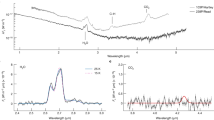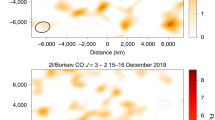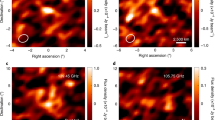Abstract
Remote sensing observations1,2,3,4,5 and the direct sampling of material6,7,8 from a few comets have established the characteristic composition of cometary gas. This gas is ionized by solar ultraviolet radiation and the solar wind to form ‘pick-up’ ions9,10,11, ions in a low ionization state that retain the same compositional signatures as the original gas. The pick-up ions are carried outward by the solar wind, and they could in principle be detected far from the coma. (Sampling of pick-up ions has also been used to study interplanetary dust12,13, Venus’ tail14 and the interstellar medium15,16.) Here we report the serendipitous detection of cometary pick-up ions, most probably associated with the tail of comet Hyakutake, at a distance of 3.4 au from the nucleus. Previous observations have provided a wealth of physical and chemical information about a small sample of comets6,7,8,9, but this detection suggests that remote sampling of comet compositions, and the discovery of otherwise invisible comets, may be possible.
This is a preview of subscription content, access via your institution
Access options
Subscribe to this journal
Receive 51 print issues and online access
$199.00 per year
only $3.90 per issue
Buy this article
- Purchase on Springer Link
- Instant access to full article PDF
Prices may be subject to local taxes which are calculated during checkout



Similar content being viewed by others
References
Huebner,W. F. & Benkhoff,J. From coma abundances to nucleus composition. Space Sci. Rev. 90, 117– 130 (1999).
Crovisier,J. & Bockelée-Morvan,D. Remote observations of the composition of cometary volatiles. Space Sci. Rev. 90, 19–32 (1999).
Biver,N. et al. Spectroscopic monitoring of comet C/1996 B2 (Hyakutake) with the JCMT and IRAM radio telescopes. Astrophys. J. 118, 1850–1872 (1999).
Combi,M. R. et al. Hubble Space Telescope ultraviolet imaging and high-resolution spectroscopy of water photodissociation products in comet Hyakutake (C/1996 B2). Astrophys. J. 494, 816– 821 (1999).
Lisse,C. M. et al. The nucleus of comet Hyakutake (C/1996 B2). Icarus 140, 189–204 ( 1999).
von Rosenvinge,T. T., Brandt,J. C. & Farquhar, R. W. The Cometary Explorer mission to comet Giacobini-Zinner. Science 232, 353–356 (1986).
Encounters with comet Halley: the first results. in Nature 321 (Suppl.), 259– 366 (1986).
Altwegg,K., Balsiger,H. & Geiss,J. Composition of the volatile material in Halley's coma from in situ measurements. Space Sci. Rev. 90, 3–18 (1999).
Ipavich,F. M. et al. Comet Giacobini-Zinner - In situ observations of energetic heavy ions. Science 232, 366– 369 (1986).
Gloeckler,G. et al. Cometary pick-up ions observed near Giacobini-Zinner. Geophys. Res. Lett. 13, 251–254 (1986).
Neugebauer,M. et al. The density of cometary protons upstream of comet Halley's bow shock. J. Geophys. Res. 94, 1261– 1269 (1989).
Geiss,J., Gloeckler,G., Fisk,L. A. & von Steiger,R. C+ pickup ions in the heliosphere and their origin. J. Geophys. Res. 100, 23373–23377 ( 1995).
Gloeckler,G., Fisk,L. A., Geiss,J., Schwadron,N. A. & Zurbuchen, T. H. Elemental composition of the inner source pickup ions. J. Geophys. Res. 105, 7459– 7463 (2000).
Grünwaldt,H. et al. Venus tail ray observation near Earth. Geophys. Res. Lett. 24, 1163–1166 (1997).
Gloeckler,G. et al. Detection of interstellar pickup hydrogen in the solar system. Science 261, 70–73 (1993).
Gloeckler,G. & Geiss,J. Interstellar and inner source pickup ions observed with SWICS on Ulysses. Space Sci. Rev. 86, 127–159 (1998).
Balsiger,H. et al. Ion composition and dynamics at comet Halley. Nature 321, 330–336 ( 1986).
Gloeckler,G. et al. The solar wind ion composition spectrometer. Astron. Astrophys. 92 (Suppl. Ser.) 267–289 (1992).
Jones,G. H., Balogh,A. & Horbury,T. S. Identification of comet Hyakutake's extremely long ion tail from magnetic field signatures. Nature 404, 574–576 (2000).
Ip,W. H. & Axford,W. I. The formation of a magnetic-field-free cavity at Comet Halley. Nature 325, 418– 419 (1987).
Biermann,L. Kometenschweife und solare Korpuskularstrahlung. Z. Naturforsch. 7a, 127–136 ( 1952).
Kissel,J. et al. Composition of comet Halley dust particles from Giotto observations. Nature 321, 336–337 (1986).
Geiss,J. Composition measurements and the history of cometary matter. Astron. Astrophys. 187, 859–866 (1987).
Geiss,J., Altwegg,K., Balsiger,H. & Graf,S. Rare atoms, molecules and radicals in the coma of P/Halley. Space Sci. Rev. 90, 253–269 (1999).
Neugebauer,M. et al. Densities and abundances of hot cometary ions in the coma of P/Halley. Astrophys. J. 372, 291– 300 (1991).
Altwegg,K. et al. The ion population between 1300 km and 230000 km in the coma of comet P/Halley. Astron. Astrophys. 279, 260–266 (1993).
Grevesse,N. & Sauval,A. J. Standard solar composition. Space Sci. Rev. 85, 161–174 (1998).
Schmidt,H. U. & Wegmann,R. in Comets (ed. Wilkening, L. L.) 538–560 (Univ. Arizona Press, Tucson, 1982).
Riley,P., Gosling,J. T. & McComas, D. J. Ulysses observations of a “density hole” in the high-speed solar wind. J. Geophys. Res. 103, 1933–1940 (1998).
Jokipii,J. R. & Parker,E. N. Random walk of magnetic lines of force in astrophysics. Phys. Rev. Lett. 21, 44–47 (1968).
Acknowledgements
The SWICS instrument was developed by a collaboration of the universities of Maryland, Bern and Braunschweig, and the Max-Planck Institut für Aeronomie. We thank C. Gloeckler for help with data reduction, and M. R. Combi and M. F. A’Hearn for discussions. This work was supported by NASA/JPL and the Swiss National Science Foundation.
Author information
Authors and Affiliations
Corresponding author
Rights and permissions
About this article
Cite this article
Gloeckler, G., Geiss, J., Schwadron, N. et al. Interception of comet Hyakutake's ion tail at a distance of 500 million kilometres. Nature 404, 576–578 (2000). https://doi.org/10.1038/35007015
Received:
Accepted:
Issue Date:
DOI: https://doi.org/10.1038/35007015
This article is cited by
-
The Science of Sungrazers, Sunskirters, and Other Near-Sun Comets
Space Science Reviews (2018)
-
On the chronology of lunar origin and evolution
The Astronomy and Astrophysics Review (2013)
-
Shock Acceleration of Ions in the Heliosphere
Space Science Reviews (2012)
-
Plasma Flow and Related Phenomena in Planetary Aeronomy
Space Science Reviews (2008)
-
Pickup Ions and Cosmic Rays from Dust in the Heliosphere
Space Science Reviews (2007)
Comments
By submitting a comment you agree to abide by our Terms and Community Guidelines. If you find something abusive or that does not comply with our terms or guidelines please flag it as inappropriate.



